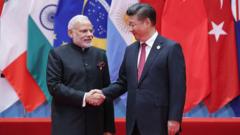As the largest global exporter of human hair, India is transforming its struggling wig industry into a lucrative market. With changing perceptions about wigs and advanced production techniques, stakeholders are advocating for increased investment and innovation to tap into the billion-dollar potential of the sector.
Embracing Hair: India's Hidden Gold Mine in the Wig Industry

Embracing Hair: India's Hidden Gold Mine in the Wig Industry
The evolution of the human hair market in India highlights untapped potential for economic growth within fashion and sustainability.
In India, human hair has emerged as a cornerstone of the global wig market, with the nation selling 85% of the world's supply. Drag artist Zeeshan Ali, known for his vibrant performances and a stunning array of 45 wigs, reinforces the pivotal role of hairpieces in self-expression and identity. “The right wig helps me transition from my everyday self into exaggerated and whimsical characters,” Ali notes, emphasizing the importance of accessibility to quality wigs—a challenge that plagued him during the beginnings of his career due to sourcing difficulties.
In recent years, societal attitudes towards wigs have shifted dramatically. No longer limited to drag acts or film, wigs are becoming mainstream fashion accessories, embraced by women across diverse backgrounds to showcase personal style. The economic landscape surrounding hair collection is multifaceted, as Kolachi Venkatesh, a Chennai-based hair collector, explains. “My parents were hair pickers, and I followed in their footsteps,” he states, revealing the reality of picking hair from households and salons for sale at less than a dollar per kilogram. A diligent collector may earn barely above minimum wage, underscoring the disparity between their hard labor and the market's profits, governed largely by intermediaries.
Most Indian hair collected eventually finds its way to China, where a flourishing wig-making industry worth five to six billion dollars prevails. Benjamin Cherian, from Plexconcil, stresses the need for India to enhance its manufacturing capabilities to compete effectively. With investment and development in innovative production techniques, India has the potential to go from exporting raw hair to crafting high-value wigs, possibly worth thousands of dollars.
One company, Diva Divine Hair, co-founded by Nidhi Tiwari in 2009, is stepping up to meet this rising demand. They produce high-quality wigs and extensions, capitalizing on the increasing issues of hair loss and changing societal norms that encourage open conversations about wigs. Tiwari highlights the advancement in production technology, introducing features such as breathable wig caps and 3D-printed wigs, emphasizing comfort and personalization.
Remy or Temple hair, sourced primarily from southern Hindu temples during religious rituals, also plays a considerable role in the market. George Cherion of Raj Hair International indicates that this high-value hair type, characterized by its aligned cuticles and silky texture, is particularly sought after.
As the global appetite for Indian hair surges, Zeeshan Ali envisions a future with more affordable, locally-made wigs that can create a wow factor for performers and consumers alike. Together, the collective push for innovation, investment, and awareness may unlock the true potential of India's hair industry.
In recent years, societal attitudes towards wigs have shifted dramatically. No longer limited to drag acts or film, wigs are becoming mainstream fashion accessories, embraced by women across diverse backgrounds to showcase personal style. The economic landscape surrounding hair collection is multifaceted, as Kolachi Venkatesh, a Chennai-based hair collector, explains. “My parents were hair pickers, and I followed in their footsteps,” he states, revealing the reality of picking hair from households and salons for sale at less than a dollar per kilogram. A diligent collector may earn barely above minimum wage, underscoring the disparity between their hard labor and the market's profits, governed largely by intermediaries.
Most Indian hair collected eventually finds its way to China, where a flourishing wig-making industry worth five to six billion dollars prevails. Benjamin Cherian, from Plexconcil, stresses the need for India to enhance its manufacturing capabilities to compete effectively. With investment and development in innovative production techniques, India has the potential to go from exporting raw hair to crafting high-value wigs, possibly worth thousands of dollars.
One company, Diva Divine Hair, co-founded by Nidhi Tiwari in 2009, is stepping up to meet this rising demand. They produce high-quality wigs and extensions, capitalizing on the increasing issues of hair loss and changing societal norms that encourage open conversations about wigs. Tiwari highlights the advancement in production technology, introducing features such as breathable wig caps and 3D-printed wigs, emphasizing comfort and personalization.
Remy or Temple hair, sourced primarily from southern Hindu temples during religious rituals, also plays a considerable role in the market. George Cherion of Raj Hair International indicates that this high-value hair type, characterized by its aligned cuticles and silky texture, is particularly sought after.
As the global appetite for Indian hair surges, Zeeshan Ali envisions a future with more affordable, locally-made wigs that can create a wow factor for performers and consumers alike. Together, the collective push for innovation, investment, and awareness may unlock the true potential of India's hair industry.



















